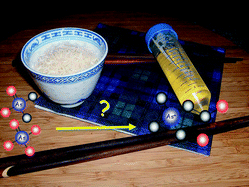Accumulation or production of arsenobetaine in humans?†
Abstract

* Corresponding authors
a
TESLA (Trace Element Speciation Laboratory) and Marine Biodiscovery Laboratory, University of Aberdeen, Aberdeen, Scotland, UK
E-mail:
j.feldmann@abdn.ac.uk
b Institute of Biological and Environmental Sciences, University of Aberdeen, Cruickshank Building, St Machar Drive, Aberdeen, UK
c Faculty of Health and Life Sciences, De Montfort University, The Gateway, Leicester, UK

 Please wait while we load your content...
Something went wrong. Try again?
Please wait while we load your content...
Something went wrong. Try again?
C. Newcombe, A. Raab, P. N. Williams, C. Deacon, P. I. Haris, A. A. Meharg and J. Feldmann, J. Environ. Monit., 2010, 12, 832 DOI: 10.1039/B921588C
To request permission to reproduce material from this article, please go to the Copyright Clearance Center request page.
If you are an author contributing to an RSC publication, you do not need to request permission provided correct acknowledgement is given.
If you are the author of this article, you do not need to request permission to reproduce figures and diagrams provided correct acknowledgement is given. If you want to reproduce the whole article in a third-party publication (excluding your thesis/dissertation for which permission is not required) please go to the Copyright Clearance Center request page.
Read more about how to correctly acknowledge RSC content.
 Fetching data from CrossRef.
Fetching data from CrossRef.
This may take some time to load.
Loading related content
